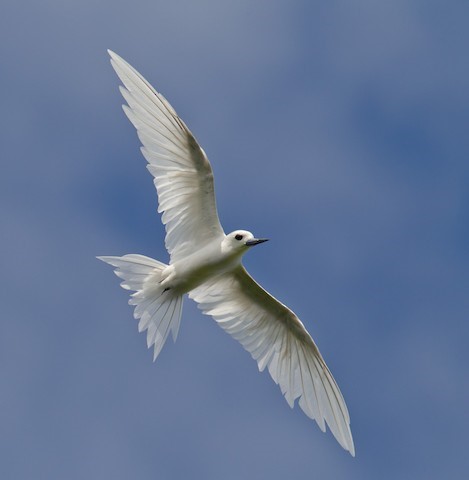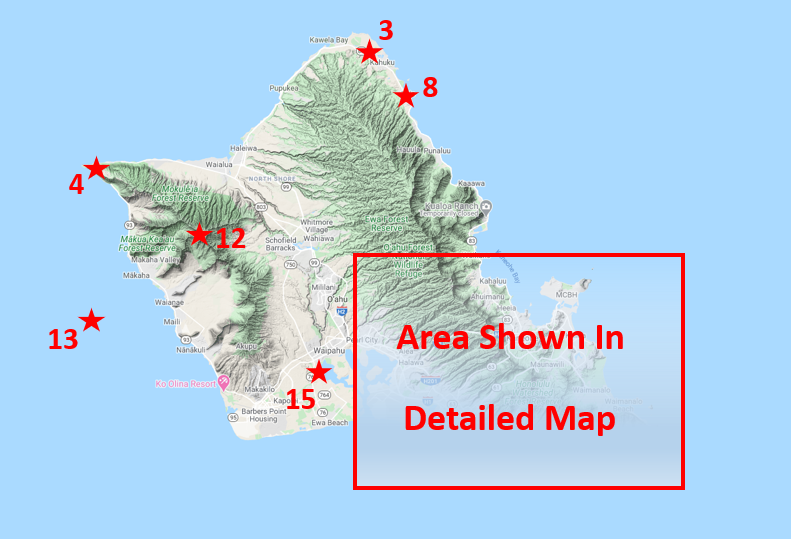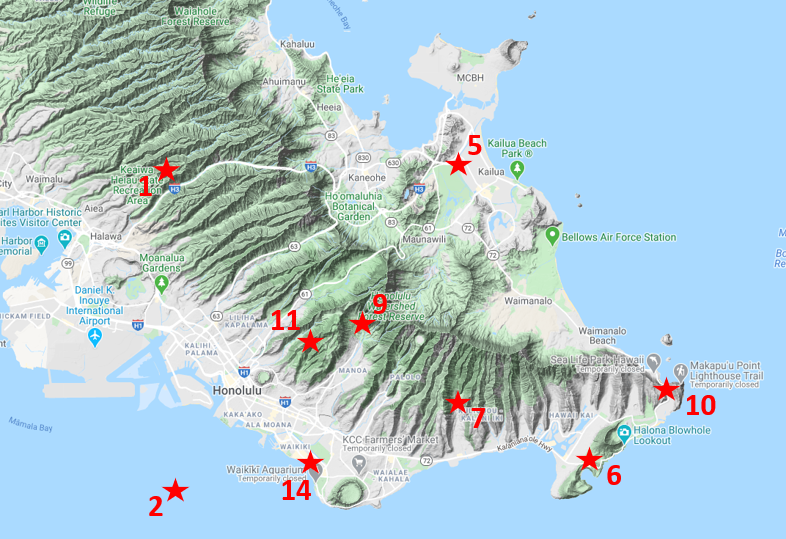The Avitourist’s Guide to Oahu

The endemic Oahu Elepaio. © Charlie Bostwick
Oahu is by far the most developed and most visited of the Hawaiian Islands, home to the vast majority of Hawaii residents and their cars. Among the four principal islands, Oahu has the fewest remaining endemic landbirds—two, the Oahu Elepaio and Oahu Amakihi—but it compensates with a disproportionately high diversity of seabirds and an extraordinary introduced species, the Mariana Swiftlet, which is otherwise confined to the Mariana Islands. Both of Oahu’s endemics can be found in the hills above Honolulu at Aiea Ridge and Kuli’ou’ou Kalani Iki (Sites #1 and #7 on the map below), but Aiea Ridge is the only site where the swiftlet is regularly reported.
Forests
Despite extensive development, Oahu retains a substantial amount of forest cover, most of which clings to the steep terrain of its two low mountain ranges, the Wai’anae in the west and the Ko’olau in the east. In the era of Captain Cook’s arrival, Oahu’s forests supported an additional six endemic songbirds, all of which are thought to have succumbed to avian malaria, which was inadvertently introduced to the island by early European visitors. Two, the Oahu Alauahio and Oahu Akepa, are known to have survived into the 1900s. The other four survived just long enough for specimens to be collected in the early or mid-1800s: Amaui, Oahu O’o, Oahu Nukupu’u, and Oahu Akialoa.
Endemic Birds of Oahu
Wetlands
Oahu has more extensive wetlands than the other main Hawaiian Islands. Three endemic waterbirds are common: “Hawaiian Gallinule”, Hawaiian Coot, and “Hawaiian Stilt”. All of these can be found easily at several locations, including the Kailua and West Loch areas (Sites #5 and #15) and James Campbell National Wildlife Refuge (Site #3). Another endemic species, the Hawaiian Duck, is rare on Oahu, but records suggest that it may be increasing. Most recent sightings have been at James Campbell N.W.R., which is also the prime location to see the rare Bristle-thighed Curlew.
Other Hawaiian Endemics Found on Oahu
Seabirds
Oahu is remarkable for its seabirds, with large breeding colonies on several nearshore islets and in protected areas on the island itself. Amazingly, the city of Honolulu is itself a seabird nesting colony, as it hosts a unique urban population of tree-nesting Common Fairy-Terns, which first arrived in the 1960s and have continued to multiply ever since.
A short drive east of Honolulu, Lanai Lookout (at Koko Head District Park, Site #6) and Makapu’u Point (Site #3) are excellent vantage points for tropicbirds (Yellow-billed, Red-tailed, and sometimes Red-billed), Wedge-tailed Shearwater, Great Frigatebird, boobies (Red-footed, “Forster’s”, and sometimes Masked), Brown and “Hawaiian” Noddies, and Sooty Tern. These sites also occasionally yield sightings of Bulwer’s Petrel and the rare Gray-backed Tern.
At the northern tip of Oahu, a protected (fenced and access-restricted) area within James Campbell National Wildlife Refuge has been dedicated to the translocation of nesting seabirds from the Northwest Chain, including Laysan and Black-footed Albatrosses, Tristram’s Storm-Petrel, and Bonin Petrel. This project began in the mid-2010s with the purpose of improving these species’ long-term survival prospects by leading them to nesting areas that are not imminently susceptible to a rising sea level.
At the western tip of Oahu, Ka’ena Point Natural Area Reserve (Site #4) protects a colony of Laysan Albatrosses and Wedge-tailed Shearwaters, but allows visitors to enter the protected area and see the birds up close, along with Hawaiian Monk Seals and Humpback Whales.
Finally, Oahu is among the best bases for offshore pelagic trips, which may depart from either Honolulu or Wai’anae. Trips out of these ports can additionally yield many other species, such as Black-winged, Cook’s, Stejneger’s, Kermadec, Mottled, Murphy’s and White-necked Petrels, and Christmas Shearwater.
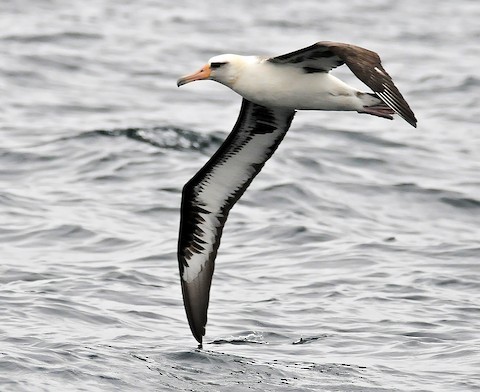
Laysan Albatross nests at Oahu’s western and northern tips. © Steven Mlodinow

Bonin Petrel was first confirmed breeding on Oahu in 2021. © Eric VanderWerf
Exotics
Oahu has more than its fair share of exotic (i.e., non-native) species, including the world’s only known introduced population of swifts, the Mariana Swiftlet, which can sometimes be seen at Aiea Ridge. Another species, the Yellow-faced Grassquit, is not established anywhere else in the U.S., although it occurs naturally from time to time as a vagrant to Florida and Texas.
Four more of Oahu’s exotics also have introduced populations on the U.S. mainland, but not on any of the other islands: Red-crowned Parrot and Red-whiskered and Red-vented Bulbuls. Several more are established on one or more other islands but tend to be easier to find on Oahu: Indian Peafowl, Rose-ringed and Red-masked Parakeets, White-rumped Shama, Red-billed Leiothrix, Red Avadavat, Chestnut Munia, Java Sparrow, Yellow-fronted Canary, Red-crested Cardinal, and Saffron Finch.
Planning a Visit
Oahu is a relatively straightforward destination for vacationers. Most visitors either stay on the island for about a week or pass through en route to another destination. Those with enough time should consider dividing it between Honolulu and one or more of the northern, western, or eastern tips of the island.
Honolulu
Honolulu is one of the world’s best cities for birdwatching—which seems counterintuitive, considering that most of its native songbirds went extinct long ago. Most visitors spend at least one night, if not several, at a hotel in Waikiki, which is occupied by several interesting species from around the globe. The city abuts the Ko’olau Range, which offers a surprisingly large number of hiking options, including Aiea Ridge, Oahu’s key site, where a visiting birdwatcher can find all three species that are effectively unique to the island.
Waikiki (Site #14): The tourist hub of Waikiki is the first stop on many travelers’ Hawaiian itineraries. Those who notice birds will find more introduced species than native ones. Fortunately, they are also likely to see Honolulu’s peculiar specialty, the Common Fairy-Tern, a dainty and ethereal seabird which, for reasons unknown, colonized the city in the late 1900s, and is not readily found elsewhere in the main Hawaiian Islands. Waikiki is a good place to find it, along with various transplanted species such as: Eastern Spotted and Zebra Doves, Rose-ringed Parakeet, Red-vented and Red-whiskered Bulbuls, Common Myna, Common Waxbill, Java Sparrow, Yellow-fronted Canary, Red-crested Cardinal, and Saffron Finch.
Aiea Ridge (Site #1): Aiea Ridge is the most productive place to search for forest birds on Oahu, with local populations of both of the island’s remaining endemics, the Oahu Elepaio and the Oahu Amakihi, and its other surviving honeycreeper, the Apapane. It is the world’s most accessible site for Mariana Swiftlet, which often hunts over the ridge due to its proximity to the colony in the North Halawa Valley, and it is within the home range of a large flock of introduced Red-crowned Parrots. Other exotics often found along the trail include White-rumped Shama, Japanese Bush-Warbler, Warbling White-eye, and Red-billed Leiothrix.
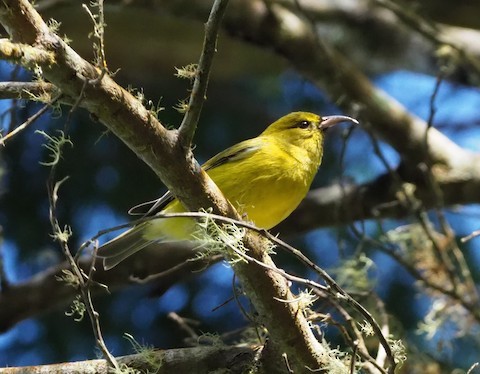
The endemic Oahu Amakihi can be found in the hills above Honolulu. © Stephan Lorenz

Mariana Swiftlet in its tunnel colony in Oahu’s North Halawa Valley, near Aiea Ridge. © Nathan Christopher Johnson
Kuli’ou’ou Kalani Iki (Site #7): Kuli’ou’ou Kalani Iki is a hilly district of East Honolulu where the Oahu Elepaio and the Oahu Amakihi are found consistently, along with the Apapane, which is more sporadic. These birds can be found along a handful of popular hiking trails through forests that also support populations of several exotic species, as at Aiea Ridge.
Lyon Arboretum (Site #9): The Lyon Arboretum is a botanical garden in the hills of Honolulu with an extensive trail network. It is one of the more accessible sites for the endemic Oahu Amakihi and one of the more consistent sites to observe White-rumped Shama. Several other escaped species have inhabited the area, including a mixed flock of cockatoos (mostly Salmon-crested and Sulphur-crested) intermittently since the 1970s and a flock of Common Hill Mynas from the 1960s to the 1990s.
Makiki (Site #11): The hills overlooking downtown Honolulu are popular for day hikes and panoramic views of the city. The most efficient way to reach this area is via Tantalus Drive. Both of Oahu’s surviving honeycreepers, Apapane and Oahu Amakihi, can sometimes be seen there—the latter more consistently than the former. It is also among the most accessible places to find certain introduced species, such as White-rumped Shama, Red-whiskered Bulbul, and Red-billed Leiothrix.
East
The eastern coastline of Oahu, beyond the urban zone of Honolulu, alternates between rugged volcanic headlands and sandy crescent beaches. The coastal highway connecting East Honolulu to Kailua is a popular scenic drive that includes several “lookouts” and trails with distant views of Molokai, Maui, and Lanai on the horizon, and much nearer views of three species of tropicbirds. The nearshore waters are dotted with islets that support the largest seabird colonies in the main Hawaiian Islands, including the only established nesting sites for Christmas Shearwater, Masked Booby, Brown Noddy, and Sooty and Gray-backed Terns.
Koko Head District Park (Site #6): Koko Head District Park is a popular recreation area on the eastern outskirts of urban Honolulu that offers various outdoor activities in a scenic setting. The area of primary interest for birds is the dramatic Ka Iwi Coast, particularly the Lanai Lookout, which is known for its exceptionally accessible colony of Red-tailed Tropicbird, frequent sightings of Yellow-billed and Red-billed Tropicbirds, and occasional sightings of Gray-backed Tern, among other locally common seabirds, including Wedge-tailed Shearwater, Great Frigatebird, Red-footed, “Forster’s”, and Masked Boobies, Common Fairy-Tern, Brown and “Hawaiian” Noddies, and Sooty Tern.
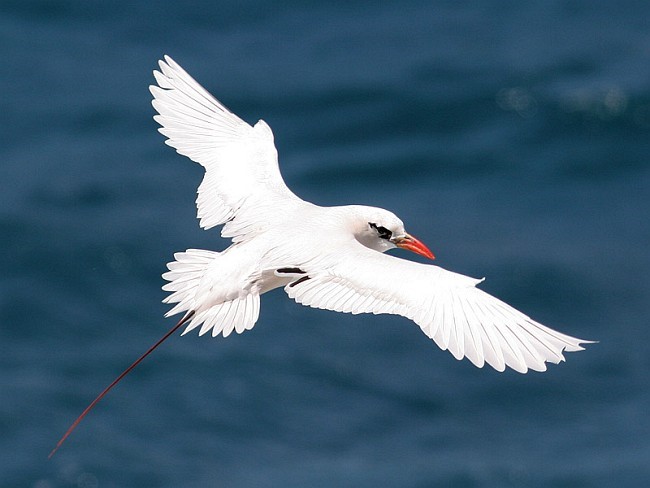
Red-tailed Tropicbirds nest beside the highway along the Ka Iwi Coast. © Cherry Wong
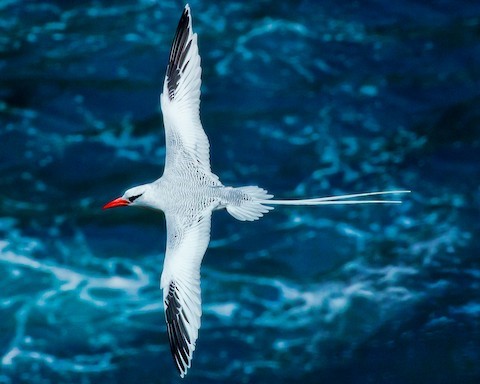
Red-billed Tropicbird is a rare visitor to the Ka Iwi Coast. © graichen & recer
Makapu’u Point (Site #10): Makapu’u Point is within view of Manana Island, the largest colony of Brown Noddies and Sooty Terns in the main Hawaiian Islands. It is also one of the most conveniently accessible sites in Hawaii for seeing several other seabirds, including: Yellow-billed and Red-tailed Tropicbirds, Wedge-tailed Shearwater, Great Frigatebird, Red-footed, “Forster’s”, and Masked Boobies, and Common Fairy-Tern, and offers the possibility of Bulwer’s Petrel, Christmas Shearwater, “Hawaiian Noddy”, and Gray-backed Tern.
Kailua (Site #5): The town of Kailua is known mainly for its beaches and Marine Corps base, but it is also a haven for waterbirds. Kawainui Marsh and other wetlands provide habitat for the endemic “Hawaiian Gallinule”, Hawaiian Coot, and “Hawaiian Stilt”, and various introduced songbirds, including Japanese Bush-Warbler, Red Avadavat and four commoner waxbills. Security at the marine base has tightened since the 1990s, so the famous Red-footed Booby colony at Ulupau Head and its distant views of Moku Manu are generally closed to non-military visitors, but it remains possible to paddle a kayak out to the Wedge-tailed Shearwater colony on the Mokulua Islets.
North
The North Shore of Oahu is best known for monster waves and the destination resort at Turtle Bay. It is also gaining status a destination for birdwatchers, with the acquisition of property to complete James Campbell N.W.R. and implement an ambitious conservation agenda that includes relocations of imperiled bird species from the inaccessible Northwest Chain as insurance against their otherwise certain demise under anticipated sea level rise. The fully realized vision will be years in the making, but the northern tip of Oahu is already (as of 2021) the best or only accessible site in the U.S. for finding two or three highly sought-after species.
James Campbell National Wildlife Refuge (Site #3): The ponds, marshes, and fields north of Kahuku are among the most productive landscapes in Hawaii for the gamut of wetland and open country birds. A large chunk of this terrain has been consolidated for conservation as James Campbell National Wildlife Refuge. The area is known for breeding populations of Hawaiian Coot, “Hawaiian Gallinule”, and “Hawaiian Stilt” and substantial numbers and diversity of migratory waterfowl and shorebirds, consistently including Bristle-thighed Curlews, with occasional sightings of Hawaiian Duck. A fenced plot of coastal dunes has been established as a surrogate nesting colony for seabirds, including Laysan and Black-footed Albatrosses, Tristram’s Storm-Petrel, and Bonin Petrel.
Laie Point (Site #8): Laie Point juts prominently into the ocean and allows for relatively convenient viewing of passing seabirds. It sits about a mile south of the islet Moku’auia, which hosts ~2,500 breeding pairs of Wedge-tailed Shearwaters from March to October. Hawaii’s three widespread boobies—Red-footed, “Forster’s”, and Masked—all put in regular appearances, and Brown Noddies often fly by in large numbers.
West
Western Oahu is its wildest and least visited sector. The tourist enclave at Ko Olina receives some attention as a more relaxed and family-friendly alternative to Waikiki, but the rest of the west is off the beaten path. Visitors who would find Honolulu and Waikiki oppressively congested and commercial should consider Ko Olina’s advantages as a base to explore the island. It provides convenient access to seabirds at Ka’ena Point and two deep-sea fishing marinas, forest birds on trails into the Wai’anae Range, and waterbirds around the West Loch of Pearl Harbor.
Ka’ena Point (Site #4): Ka’ena Point offers unique access to a seabird colony, where large numbers of nesting Laysan Albatrosses and Wedge-tailed Shearwaters are protected from mammalian predators by a specially constructed fence, with gates for visitors to enter the colony. Several other seabirds are often present, including: Yellow-billed and Red-tailed Tropicbirds; Black-footed Albatross; Great Frigatebird; Red-footed, “Forster’s”, and rarely Masked Boobies; Brown and “Hawaiian” Noddies; and rarely Gray-backed Tern. It is also among the few consistent sites for Yellow-faced Grassquit.
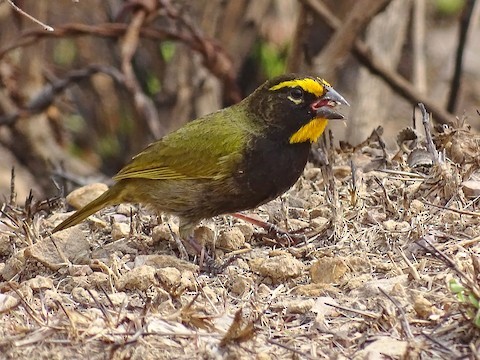
Yellow-faced Grassquit can often be found along the southern trail to Ka’ena Point. © Alfonso Auerbach
Mount Ka’ala (Site #12): Western Oahu receives little attention from tourists, and public access to several potentially interesting areas is restricted. One exception is the trail up Wai’anae Valley to the highest point on the island, Mount Ka’ala, which is open to visitors who are inclined to strenuous hikes. The trail offers a good chance of finding Oahu Amakihi and Apapane, as well as some introduced species that are uncommon or absent from eastern Oahu: Erckel’s Francolin, Kalij Pheasant, and Indian Peafowl. At least until recently, and perhaps still, the valley has also harbored a few pairs of Oahu Elepaio.
West Loch, Pearl Harbor (Site #15): Pearl Harbor is an unusually extensive marine lagoon system that has a narrow entrance from the ocean, then forks into three bays or lochs. The eastern and central portions are mostly off-limits, but the West Loch has some partly accessible wetlands that are managed to preserve some of Pearl Harbor’s natural heritage. In addition to many migrants, three of Hawaii’s endemic waterbirds are common residents: “Hawaiian Gallinule”, Hawaiian Coot, and “Hawaiian Stilt”. The brushy and grassy margins support large numbers of introduced birds, including Gray Francolin, White-rumped Shama, and six waxbill species, including Red Avadavat.
